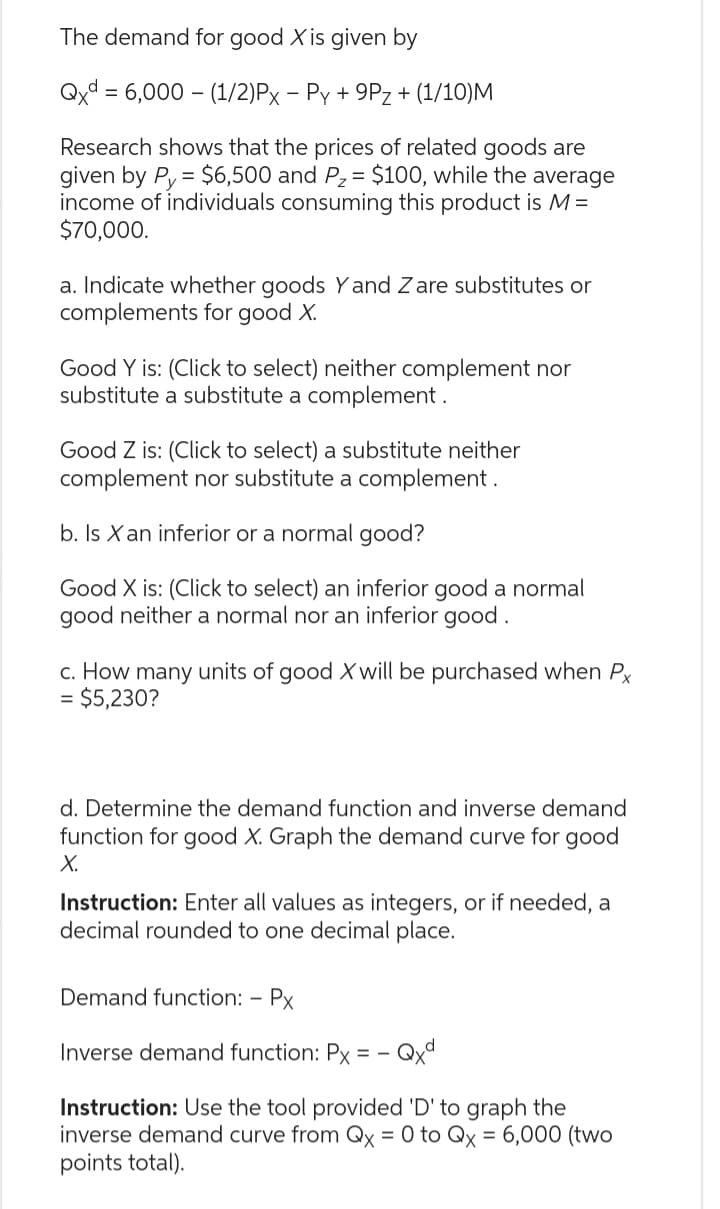a. Indicate whether goods Y and Z are substitutes or complements for good X. Good Y is: (Click to select) neither complement nor substitute a substitute a complement. Good Z is: (Click to select) a substitute neither complement nor substitute a complement. b. Is X an inferior or a normal good?
a. Indicate whether goods Y and Z are substitutes or complements for good X. Good Y is: (Click to select) neither complement nor substitute a substitute a complement. Good Z is: (Click to select) a substitute neither complement nor substitute a complement. b. Is X an inferior or a normal good?
Chapter5: Income And Substitution Effects
Section: Chapter Questions
Problem 5.1P
Related questions
Question
Note: The answer should be typed.

Transcribed Image Text:The demand for good X is given by
Qxd = 6,000 (1/2)Px − Py + 9Pz + (1/10)M
Research shows that the prices of related goods are
given by Py = $6,500 and P₂ = $100, while the average
income of individuals consuming this product is M =
$70,000.
a. Indicate whether goods Y and Z are substitutes or
complements for good X.
Good Y is: (Click to select) neither complement nor
substitute a substitute a complement.
Good Z is: (Click to select) a substitute neither
complement nor substitute a complement.
b. Is X an inferior or a normal good?
Good X is: (Click to select) an inferior good a normal
good neither a normal nor an inferior good.
c. How many units of good X will be purchased when Px
= $5,230?
d. Determine the demand function and inverse demand
function for good X. Graph the demand curve for good
X.
Instruction: Enter all values as integers, or if needed, a
decimal rounded to one decimal place.
Demand function: - Px
Inverse demand function: Px ==
- Qxd
Instruction: Use the tool provided 'D' to graph the
inverse demand curve from Qx = 0 to Qx = 6,000 (two
points total).
Expert Solution
This question has been solved!
Explore an expertly crafted, step-by-step solution for a thorough understanding of key concepts.
This is a popular solution!
Trending now
This is a popular solution!
Step by step
Solved in 5 steps with 15 images

Knowledge Booster
Learn more about
Need a deep-dive on the concept behind this application? Look no further. Learn more about this topic, economics and related others by exploring similar questions and additional content below.Recommended textbooks for you







Microeconomics: Principles & Policy
Economics
ISBN:
9781337794992
Author:
William J. Baumol, Alan S. Blinder, John L. Solow
Publisher:
Cengage Learning

Economics: Private and Public Choice (MindTap Cou…
Economics
ISBN:
9781305506725
Author:
James D. Gwartney, Richard L. Stroup, Russell S. Sobel, David A. Macpherson
Publisher:
Cengage Learning

Microeconomics: Private and Public Choice (MindTa…
Economics
ISBN:
9781305506893
Author:
James D. Gwartney, Richard L. Stroup, Russell S. Sobel, David A. Macpherson
Publisher:
Cengage Learning